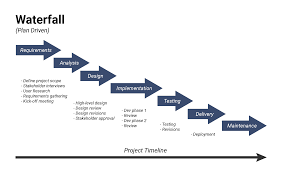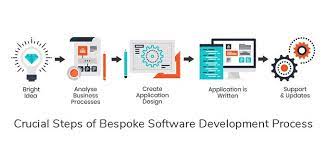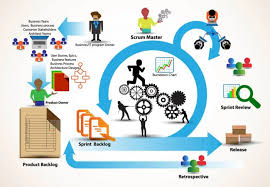The Waterfall Development Model: A Comprehensive Guide
The waterfall model is a traditional approach to software development that follows a linear and sequential process. It consists of several distinct phases, each of which must be completed before the next one can begin.
Phases of the Waterfall Model:
- Requirements Gathering: In this initial phase, project requirements are gathered and documented in detail.
- System Design: The system architecture is designed based on the requirements gathered in the previous phase.
- Implementation: The actual coding and programming of the software takes place in this phase.
- Testing: Once the implementation is complete, rigorous testing is performed to identify and fix any bugs or issues.
- Deployment: The final product is deployed to the end-users after successful testing.
- Maintenance: Ongoing maintenance and support activities are carried out to ensure the software operates effectively.
Advantages of Waterfall Development:
- Predictable and easy to understand.
- Clear documentation at each stage of development.
- Suitable for small projects with well-defined requirements.
Disadvantages of Waterfall Development:
- No room for changes once a phase is completed.
- Risk of delivering an outdated product due to long development cycles.
- Potential for customer dissatisfaction if requirements change mid-project.
8 Advantages of Waterfall Development for Project Management
- Clear and well-defined project requirements at the beginning.
- Easy to understand and manage due to its linear nature.
- Structured approach with distinct phases for development.
- Documentation is detailed and thorough at each stage.
- Suitable for projects with stable requirements that are unlikely to change.
- Helps in setting clear milestones and deadlines for project completion.
- Easier to estimate time and cost of the project upfront.
- Provides a systematic way of tracking progress throughout the development process.
Challenges of Waterfall Development: Inflexibility, Outdated Deliverables, and Customer Dissatisfaction
- No room for changes once a phase is completed.
- Risk of delivering an outdated product due to long development cycles.
- Potential for customer dissatisfaction if requirements change mid-project.
Clear and well-defined project requirements at the beginning.
One of the key advantages of the waterfall development model is the presence of clear and well-defined project requirements at the beginning of the project. This ensures that all stakeholders have a common understanding of what needs to be achieved, which helps in setting clear goals and expectations for the project. Having detailed requirements upfront also minimizes misunderstandings and reduces the likelihood of scope creep later in the development process. This clarity at the outset can lead to a smoother development process, as teams can proceed with confidence knowing exactly what needs to be delivered.
Easy to understand and manage due to its linear nature.
One of the key advantages of the waterfall development model is its ease of understanding and management, attributed to its linear nature. The sequential progression through distinct phases makes it straightforward for stakeholders to grasp where the project stands at any given time. This clear structure also facilitates effective project management, as it allows for better planning and allocation of resources based on the defined milestones within each phase.
Structured approach with distinct phases for development.
One of the key advantages of the waterfall development model is its structured approach with distinct phases for development. This sequential method allows for a clear and systematic progression through each stage of the project, ensuring that requirements are well-defined and understood before moving on to the next phase. By following a predetermined set of steps, teams can effectively plan, execute, and monitor progress throughout the development process, leading to better organization and accountability within the project team.
Documentation is detailed and thorough at each stage.
One of the key advantages of the waterfall development model is that documentation is detailed and thorough at each stage of the process. This meticulous documentation ensures that all project requirements, design decisions, and implementation details are well-documented and easily accessible. Having comprehensive documentation at every stage helps in maintaining clarity, facilitating communication among team members, and providing a clear reference point for future stages of development or for any necessary maintenance tasks.
Suitable for projects with stable requirements that are unlikely to change.
One of the key advantages of the waterfall development model is its suitability for projects with stable requirements that are unlikely to change. In such cases, the linear and sequential nature of the waterfall model allows for a systematic approach to be followed, ensuring that each phase is completed thoroughly before moving on to the next. This predictability and structure make it easier to plan and execute the project efficiently, leading to a higher likelihood of meeting project deadlines and staying within budget.
Helps in setting clear milestones and deadlines for project completion.
One of the key benefits of the waterfall development model is its ability to help in setting clear milestones and deadlines for project completion. By following a sequential approach with distinct phases, teams can establish specific goals and timelines for each stage of the project. This clarity in milestones and deadlines allows for better project planning, resource allocation, and overall progress tracking, ultimately aiding in the successful and timely completion of the project.
Easier to estimate time and cost of the project upfront.
One of the key advantages of the waterfall development model is that it allows for easier estimation of both time and cost of the project upfront. By following a sequential and linear approach with clearly defined phases, project managers can more accurately predict the resources required at each stage. This predictability helps in setting realistic timelines and budgets from the beginning, providing stakeholders with a clear understanding of what to expect throughout the development process.
Provides a systematic way of tracking progress throughout the development process.
One of the key advantages of the waterfall development model is its ability to provide a systematic way of tracking progress throughout the entire development process. By following a sequential approach with clearly defined phases, stakeholders can easily monitor and measure the progress of the project at each stage. This structured tracking system helps ensure that the project stays on schedule and allows for better visibility into the development timeline, making it easier to identify any potential delays or issues early on.
No room for changes once a phase is completed.
One significant drawback of the waterfall development model is the lack of flexibility to accommodate changes once a phase is completed. This rigidity can be problematic when requirements evolve or new insights are gained during the development process. Any modifications or additions to the initial project scope may require revisiting previous phases, leading to delays, increased costs, and potential disruptions to the project timeline. This limitation highlights the importance of thorough planning and detailed requirements gathering in waterfall projects to minimize the impact of change requests.
Risk of delivering an outdated product due to long development cycles.
One significant drawback of the waterfall development model is the risk of delivering an outdated product due to long development cycles. Because each phase must be completed before moving on to the next, any changes or updates in technology, market trends, or user requirements that occur during the development process may not be addressed until the final product is delivered. This can result in a product that may no longer meet the current needs or expectations of users, leading to potential dissatisfaction and decreased competitiveness in the market.
Potential for customer dissatisfaction if requirements change mid-project.
One significant drawback of the waterfall development model is the potential for customer dissatisfaction if requirements change mid-project. Since the waterfall approach follows a strict sequential process where each phase must be completed before moving on to the next, any changes in project requirements after the initial stages can be challenging to accommodate. This lack of flexibility can lead to delays, increased costs, and ultimately, customer dissatisfaction as their evolving needs may not align with the originally defined project scope.




